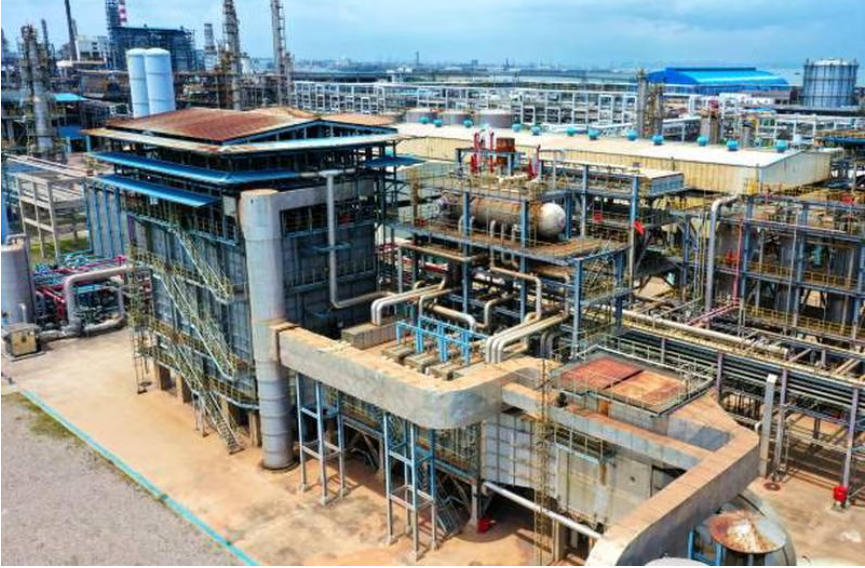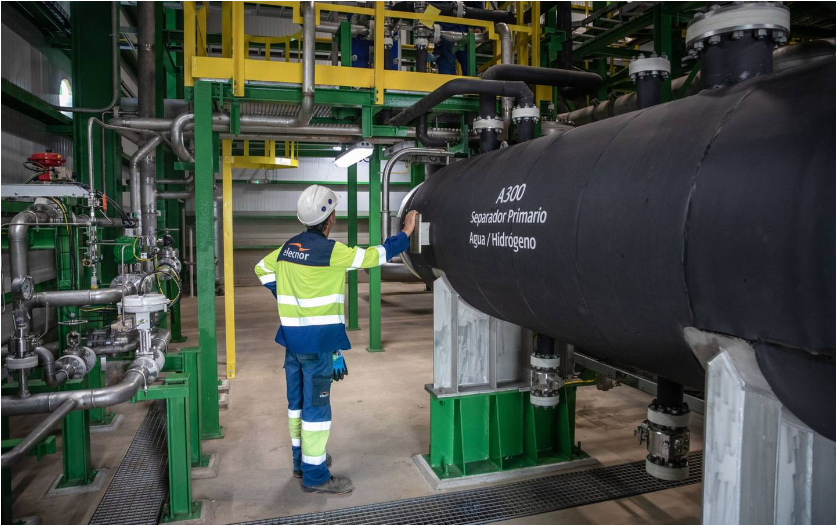
A view of the hydrogen production unit at a SinoPec refinery in Qingdao, eastern China. Feature China / Barcroft Media / Getty Images
A decade ago, China used low prices to dominate solar manufacturing, wiping out western competitors right as worldwide demand for panels started to soar. The US and Europe are determined not to let the same thing happen with hydrogen.
As the world sprints to decarbonise, the next round of competition revolves around a device called an electrolyser. Plug these into clean electricity such as solar power, and it is possible to extract hydrogen from water without producing any planet-warming emissions.
That is a crucial step in creating a green fuel capable of decarbonising industries such as steel, cement or shipping.
Companies around the world are already revving up electrolyser production, green hydrogen plants are under construction and the industry is finally making the leap from pilot projects to industrial scale.
BloombergNEF, a clean energy research group, estimates worldwide electrolyser production will need to grow 91 times by 2030 to meet demand.
But many western clean-tech veterans view the emerging competition with a queasy feeling of déjà vu. More than 40 per cent of all electrolysers made today come from China, according to BNEF.
Chinese electrolysers are not as efficient as those made in the US and Europe, but they cost far less — about a quarter of what western companies charge. Chinese electrolyser companies still largely serve their domestic market, but they’re starting to expand sales overseas.
“I have heard too many government officials say we cannot repeat the experience of solar again,” said BNEF hydrogen analyst Xiaoting Wang.
US President Joe Biden served as Vice President during the crucial years when China seized the lead in solar manufacturing. Now he views China as a competitor more than a supplier, and he has made bringing clean-tech manufacturing back to the US a pillar of his climate policies.
The US is determined not to let China control this new energy boom, and Mr Biden’s Inflation Reduction Act showers money on domestic hydrogen production.
“The reality is, the US is going to give very generous subsidies to ensure that local suppliers survive,” Mr Wang said.
Europe has its own reasons for wanting a piece of this nascent industry.
Russia’s invasion of Ukraine has driven home the value of fuel that can be produced within Europe, and it has ramped up the continent’s ambitions for hydrogen. And yet, some hydrogen advocates say the EU is not following through, putting it at a disadvantage to both the US and China.
The union has set a target for green hydrogen production — 10 million tonnes per year by 2030 — but has not yet decided which methods will qualify as “green”. That makes it hard for companies to commit to the big hydrogen production projects that would drive electrolyser orders.
“I’m scared the market shares in the electrolyser business will be taken away from Europe and shipped to other geographies,” said Jorgo Chatzimarkakis, chief executive of Brussels-based lobbying group Hydrogen Europe.
“The EU are shooting themselves in the head. Not in the foot — in the head.”
Meanwhile, many analysts expect the efficiency of Chinese electrolysers to improve, eroding any technological advantage US and European companies now have.
“I have no doubt that China is working on better electrolysers,” said Bridget van Dorsten, senior hydrogen analyst at the Wood Mackenzie research and consulting company.
“The day that China decides not to be a laggard any more is the day they aren’t a laggard any more.”
And some Chinese companies have a head start. Chemical-equipment manufacturers there have made electrolysers for years, installing large-scale water electrolysis systems for various manufacturing industries such as polysilicon production for solar cells.
Electrolysers use electricity to split water into hydrogen and oxygen, and versions of them have been on the market since the 1920s. Many countries now see hydrogen as the best bet for decarbonising industries that cannot easily run on electricity.
If an electrolyser’s power comes from a solar or wind facility, or a nuclear reactor, the process of producing the hydrogen is also carbon-free.
The devices come in several varieties, each with its pros and cons. Chinese companies mostly produce “alkaline” electrolysers that have low upfront costs but need more electricity than competing technologies to yield each kilogram of hydrogen.
US and European companies focus on “solid oxide” and “proton-exchange membrane” (PEM) electrolysers that have a higher initial cost but need less electricity — a big selling point in places where electricity is expensive.
Chinese manufacturers, however, are developing PEM electrolysers and refining their alkaline products. And they’re looking to foreign markets for growth.
Xi’an-based Longi Green Energy Technology Co, the world’s largest solar equipment maker, set up a hydrogen unit in March 2021 and has already built 1.5 gigawatts of electrolyser manufacturing capacity in China.
It is developing PEM but predicts that alkaline electrolysers will dominate the industry for the next five years, said Wang Yingge, vice president of Longi Hydrogen. Within three years, the company expects foreign markets to make up more than half of its sales, he said.
“Europe and the US have the most proactive incentive policies for the hydrogen industry, while the Middle East and Africa have the largest scale and most economical renewable energy,” Mr Wang said. “Green hydrogen projects in these regions have good profitability.”

A worker inspects a primary water and hydrogen separator inside the electrolyser area during the final stages of construction at Iberdola SA's Puertollano green hydrogen plant in Spain. Bloomberg
Meanwhile, state-owned Peric received orders in 2022 from seven foreign countries, including Australia, the US and Korea, according to BNEF.
Shandong Saikesaisi Hydrogen Energy, one of the few Chinese manufacturers to specialise in PEM, now gets about 10 per cent to 15 per cent of its sales from overseas, said Huang Fang, a project director of the company. It is aiming to improve that percentage amid demand from Europe and Australia.
While the electrolyser is as essential to green hydrogen as the solar cell is to solar power, there are key differences.
Solar panels are essentially an off-the-shelf technology. Whether they are set up on a rooftop or assembled in a giant desert array, the panels and the systems connected to them do not vary all that much.
That is not the case with hydrogen production. Electrolysers are only one part of a hydrogen production plant whose size and design will be dictated by its energy source and customer needs. Plug Power Inc is building a fleet of green hydrogen production plants in the US, and each is unique, said chief executive Andy Marsh.
“The plant in Texas is different from the plant in New York, which is different from the plant in Georgia,” he said. “It’s all very local.” Plug, based in Latham, New York, also makes and sells PEM electrolysers.
There are advantages to making electrolysers within the market they are intended to serve. Belgium’s John Cockerill Group established a joint venture in China — Cockerill Jingli Hydrogen — to make electrolysers for China, rather than for other countries.
The company is also investing in two factories in Europe, as well as potentially the US and India.
The equipment is complex and heavy, requiring significant on-site customisation for each customer, said Raphael Tilot, Cockerill’s head of hydrogen.
“Transporting this from China to other parts of the world isn’t that straightforward,” he said. “The level of on-site work to make it compatible with the client’s project is quite significant.”
While China’s solar industry enjoyed years of generous subsidies from the central government, which helped equipment makers dominate the global supply chain, hydrogen has yet to see the same level of policy support.
The country introduced its first state-level plan for hydrogen development early last year, but refrained from instituting any financial support policies such as subsidies, crushing hopes from equipment manufacturers.